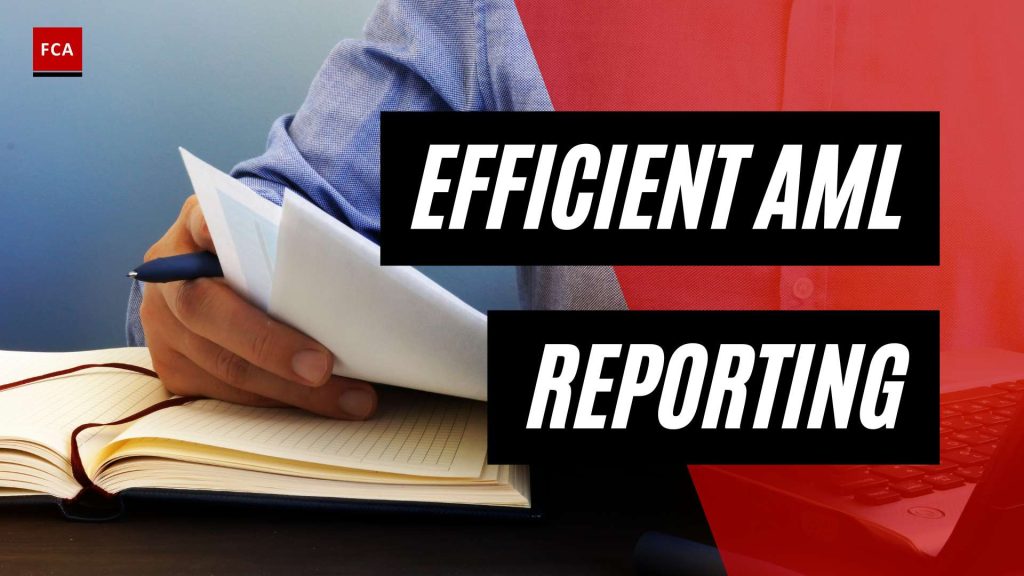AML Transaction Reporting: An Overview
In the realm of anti-money laundering (AML) regulation, AML transaction reporting plays a crucial role in identifying and mitigating risks associated with financial activities. By tracking and reporting suspicious transactions, financial institutions can comply with regulatory requirements and contribute to the prevention of money laundering and terrorist financing activities.
What is AML Transaction Reporting?
AML transaction reporting involves the systematic and timely reporting of certain financial transactions to regulatory bodies, such as financial intelligence units (FIUs) or other designated authorities. These transactions typically exceed a predetermined monetary threshold and are deemed significant for regulatory purposes.
The primary purpose of AML transaction reporting is to detect and deter illicit financial activities, including money laundering, terrorist financing, and other financial crimes. By reporting these transactions, financial institutions assist authorities in tracking and investigating suspicious activities, ultimately helping to protect the integrity of the financial system.
Importance of AML Transaction Reporting
AML transaction reporting holds considerable importance for financial institutions and the broader regulatory landscape. Here are some key reasons why AML transaction reporting is crucial:
-
Risk Identification and Mitigation: AML transaction reporting aids in creating a comprehensive profile of potential risks associated with customers, transactions, and counterparties. By systematically analyzing and reporting transactions, financial institutions can better assess the risk exposure and take appropriate measures to mitigate potential threats.
-
Regulatory Compliance: Financial institutions are obligated to comply with AML regulations and reporting requirements imposed by regulatory bodies. AML transaction reporting ensures that these institutions meet their compliance obligations and fulfill their role in combating money laundering and terrorist financing.
-
Detection of Suspicious Activities: AML transaction reporting enables the identification of patterns, anomalies, and trends in financial activities. By leveraging advanced technologies and data analytics, financial institutions can effectively detect and investigate suspicious transactions, facilitating the early detection and prevention of illicit activities.
-
Penalties and Reputational Risks: Failure to comply with AML transaction reporting requirements can result in severe penalties and reputational damage for financial institutions. Non-compliance not only exposes institutions to legal consequences but also undermines their trustworthiness in the eyes of regulators, customers, and the public. Implementing robust AML monitoring systems helps mitigate these risks.
To streamline AML transaction reporting, financial institutions can leverage AML software tools and advanced technologies. These tools automate the monitoring and reporting process, enhance transaction analysis, and ensure compliance with AML laws and regulations. By leveraging these technologies, institutions can enhance the accuracy and efficiency of their AML transaction reporting efforts.
In summary, AML transaction reporting is a vital component of the regulatory framework designed to combat money laundering and terrorist financing. It enables financial institutions to comply with reporting obligations, detect suspicious activities, and contribute to the global fight against financial crimes. By maintaining robust AML transaction reporting practices, institutions can safeguard the integrity of the financial system and protect themselves from potential legal and reputational risks.
Regulatory Framework for AML Transaction Reporting
To combat money laundering and ensure the integrity of the financial system, Anti-Money Laundering (AML) regulations have been established globally. AML transaction reporting plays a vital role in this regulatory framework, facilitating the identification and mitigation of risks associated with illicit financial activities.
AML Regulations and Reporting Requirements
AML regulations set out specific guidelines and reporting requirements that financial institutions must follow to fulfill their obligations in combating money laundering and terrorist financing activities. These regulations vary across jurisdictions but generally share common objectives of monitoring, detecting, and reporting suspicious transactions.
Financial institutions are required to implement robust AML programs that include transaction monitoring systems to identify potentially suspicious activities. The Bank Secrecy Act (BSA) in the United States, for example, mandates financial institutions to collaborate with government agencies to detect and prevent money laundering. The BSA also integrates provisions from the USA Patriot Act, which requires banks to implement customer identification measures (OCC).
The reporting obligations for financial institutions typically include the submission of Suspicious Activity Reports (SARs) and Currency Transaction Reports (CTRs). SARs are filed when a financial institution detects suspicious transactions or activities that may indicate potential money laundering or other illicit financial conduct. CTRs, on the other hand, are filed when a financial transaction exceeds a certain threshold amount set by regulatory authorities.
Reporting Obligations for Financial Institutions
Financial institutions have specific reporting obligations that are mandated by regulatory bodies. These reporting obligations ensure that suspicious activities and large transactions are properly identified, reported, and investigated. The reporting requirements vary depending on the jurisdiction, but they generally require financial institutions to:
-
File Suspicious Activity Reports (SARs): Financial institutions must file SARs within a specified timeframe when they detect information that could be the basis for suspicion. The deadline for filing SARs is typically 30 calendar days from the initial detection, but it can be extended for an additional 30 calendar days if no suspect is identified initially. However, reporting must not be delayed beyond 60 calendar days from the initial detection of the transaction.
-
Submit Currency Transaction Reports (CTRs): Financial institutions are required to submit CTRs for transactions that exceed a specified threshold amount set by regulatory authorities. CTRs provide valuable information on potentially large cash transactions, aiding in the prevention of money laundering and terrorist financing activities.
To effectively fulfill these reporting obligations, financial institutions need to have comprehensive AML programs in place, which include transaction monitoring systems, record-keeping, and reporting mechanisms. These programs should be regularly reviewed and updated to ensure compliance with evolving regulatory requirements.
Understanding the regulatory framework and reporting obligations is crucial for financial institutions to streamline their AML transaction reporting processes and maintain compliance. By adhering to these regulations, financial institutions contribute to the global fight against money laundering and uphold the integrity of the financial system.
Key Components of AML Transaction Reporting
To effectively combat money laundering and terrorist financing activities, AML transaction reporting plays a crucial role. Financial institutions must report suspicious activity and maintain proper records of these transactions to support law enforcement investigations and protect against illicit financial activities. Let’s explore the key components of AML transaction reporting: Suspicious Activity Reports (SARs), Currency Transaction Reports (CTRs), and the maintenance of records.
Suspicious Activity Reports (SARs)
Suspicious Activity Reports (SARs) are an essential component of AML transaction reporting. Financial institutions are required to file SARs when they detect transactions or patterns of activity that may indicate potential money laundering, terrorist financing, or other illegal activities. SARs provide valuable information to regulatory authorities, enabling them to investigate and take appropriate action.
When filing a SAR, financial institutions must include details such as the nature of the suspicious activity, the individuals or entities involved, and any supporting documentation. These reports play a critical role in identifying and preventing financial crimes, ensuring the integrity of the financial system.
Currency Transaction Reports (CTRs)
Currency Transaction Reports (CTRs) are another important aspect of AML transaction reporting. Financial institutions are obligated to file CTRs for any cash transactions that exceed a certain threshold set by regulatory authorities. These reports provide visibility into large cash transactions, which can help identify potential money laundering or illicit activities.
CTRs typically include information such as the customer’s identification, the amount and nature of the transaction, and the purpose of the transaction. By monitoring and reporting significant cash transactions, financial institutions contribute to the detection and prevention of money laundering and other illicit financial activities.
Maintaining Records for AML Reporting
Alongside SARs and CTRs, financial institutions must maintain appropriate records for AML reporting. These records serve as a crucial source of information for law enforcement investigations and regulatory purposes. The specific requirements for record-keeping may vary across jurisdictions, but they generally include retaining records related to SARs, CTRs, customer identification, and transaction details.
Maintaining comprehensive records allows financial institutions to demonstrate compliance with regulatory obligations and facilitates effective monitoring and analysis of transactions. It also enables the timely retrieval of information for regulatory audits and investigations.
It’s essential for financial institutions to ensure the accuracy, completeness, and accessibility of these records to meet regulatory requirements. Implementing robust record-keeping practices and utilizing AML software tools can streamline the record maintenance process and enhance compliance efforts.
By adhering to the key components of AML transaction reporting, financial institutions play a vital role in thwarting money laundering and terrorist financing activities. SARs, CTRs, and proper record-keeping enable regulatory authorities to identify suspicious activities, investigate potential financial crimes, and safeguard the integrity of the global financial system.
Implementing Effective AML Transaction Monitoring Systems
To ensure compliance with regulatory reporting requirements and combat money laundering activities, financial institutions must implement effective AML transaction monitoring systems. This involves several key components, including risk assessment and AML system design, transaction monitoring and analysis, and reporting and escalation of suspicious activities.
Risk Assessment and AML System Design
Implementing an effective AML transaction monitoring process begins with conducting a comprehensive risk assessment. This assessment helps identify the specific risks faced by the institution and enables the design of an AML system tailored to its needs. The risk assessment takes into account factors such as customer profiles, transaction volumes, geographical locations, and emerging threats. By understanding these risks, institutions can develop appropriate monitoring procedures and controls to detect and prevent suspicious activities (Sanction Scanner).
The design of the AML system should align with regulatory requirements and industry best practices. It should include policies, procedures, and automated tools that facilitate the detection of suspicious transactions. This may involve implementing transaction monitoring software that can analyze vast amounts of data and identify patterns indicative of money laundering or other illicit activities (Sanction Scanner). The aim is to establish a robust system that can detect and mitigate potential risks efficiently.
Transaction Monitoring and Analysis
Once the AML system is in place, financial institutions need to monitor transactions on an ongoing basis. Transaction monitoring involves analyzing customer transactions, account activity, and other relevant data to identify any suspicious patterns or anomalies. It is essential to establish clear and well-defined monitoring rules and parameters that align with the institution’s risk profile.
Advanced technologies, such as machine learning algorithms and data analytics, play a crucial role in transaction monitoring for AML purposes. These technologies enable the detection of complex patterns, outlier behavior, and other indicators of potential money laundering or terrorist financing activities. Regular system testing and performance analysis are also necessary to ensure the effectiveness and accuracy of the monitoring system (Sanction Scanner).
Reporting and Escalation of Suspicious Activities
An essential aspect of AML transaction monitoring is the reporting and escalation of any suspicious activities identified. Financial institutions are obligated to file Suspicious Activity Reports (SARs) with the appropriate regulatory authorities when they have reasonable grounds to suspect that a transaction is related to money laundering or other criminal activities.
The timely and accurate filing of SARs is crucial for effective AML compliance. Institutions must ensure that their reporting processes comply with regulatory guidelines, including the submission of required information, such as transaction details, customer information, and the nature of the suspicious activity. By promptly reporting suspicious activities, financial institutions contribute to the collective efforts in combating financial crimes.
Financial institutions should establish internal protocols for the escalation of suspicious activities. This includes defining the roles and responsibilities of personnel involved in the escalation process, such as compliance officers and senior management. Escalation procedures should be implemented to ensure that potential risks are promptly addressed and appropriate actions are taken.
By implementing effective AML transaction monitoring systems, financial institutions can detect and deter money laundering activities more efficiently. The combination of risk assessment, transaction monitoring, and reporting and escalation procedures helps institutions fulfill their compliance obligations and contributes to the broader efforts in combating financial crimes.
Technology Solutions for AML Transaction Reporting
In today’s complex regulatory landscape, technology plays a crucial role in streamlining AML transaction reporting processes. AML software tools and advanced technologies have emerged as effective solutions for enhancing efficiency and compliance in reporting suspicious activities. Let’s explore some key aspects of these technology solutions.
AML Software Tools and Automation
AML software tools are designed to assist businesses in automating the monitoring and reporting of transactions, ensuring compliance with AML laws and regulations. These tools utilize advanced algorithms to analyze vast amounts of transaction data and flag suspicious activities for further investigation (Seon).
Key benefits of using AML software tools include:
- Automation: AML software automates time-consuming manual processes, reducing human error and increasing operational efficiency.
- Real-time Monitoring: These tools enable real-time monitoring of transactions, customer behavior, and account data, allowing for the timely detection of suspicious activities.
- Enhanced Detection: By leveraging artificial intelligence, machine learning, and data analytics, AML software tools can identify complex money laundering schemes that traditional methods may miss.
- Regulatory Compliance: AML software tools help businesses stay compliant by adhering to regulatory reporting requirements and guidelines.
Leveraging Advanced Technologies for Transaction Monitoring
Advanced technologies are revolutionizing transaction monitoring capabilities within AML software tools. These technologies, such as artificial intelligence and machine learning, enable the detection of patterns and anomalies in transactional data, aiding in the identification of potential money laundering activities.
Key features of leveraging advanced technologies for transaction monitoring include:
- Risk Signal Analysis: Real-time risk signals, such as device fingerprinting and behavioral signals, are used to enhance understanding of risk and adjust friction accordingly during the transaction monitoring process (Persona).
- Link Analysis: Link analysis helps in uncovering and blocking fraud rings by connecting risky accounts and identifying potential money laundering activities (Persona).
- Automated Decision-making: Automation of decisions and follow-ups throughout the identity lifecycle streamlines AML transaction monitoring processes and ensures compliance with regulations.
- Enhanced Identity Verification: Advanced technologies enable robust identity verification by screening against global sanction and warning lists, politically exposed persons (PEP) lists, and conducting media checks to detect negative news associated with individuals or businesses (Persona).
Ensuring Data Quality and Compliance
The effectiveness of AML transaction reporting relies on the quality of transaction data, accuracy of monitoring rules, and the ability of software tools to adapt to evolving financial crime trends and regulatory requirements (Seon). To ensure data quality and compliance, businesses should consider the following:
- Data Validation: AML software tools should have robust data validation mechanisms in place to ensure the accuracy and integrity of transaction data.
- Regulatory Updates: These tools should be regularly updated to incorporate changes in AML regulations and reporting requirements, ensuring ongoing compliance.
- Audit Trail: Maintaining an audit trail of activities and reporting processes helps with internal and external audits, demonstrating compliance with regulatory obligations.
By leveraging AML software tools and advanced technologies, businesses can enhance their AML transaction reporting capabilities, streamline processes, and improve overall compliance. It is important to choose the right technology solution that aligns with the specific needs and regulatory requirements of the organization. Regular training and staying informed about the latest developments in regulatory reporting technology are essential to maximize the benefits of these solutions and stay ahead in the fight against money laundering and financial crime.
Consequences of Non-Compliance with AML Reporting
Adhering to AML reporting guidelines and fulfilling regulatory reporting requirements are critical for financial institutions in their efforts to combat money laundering and illicit financial activities. Failure to comply with these obligations can result in significant consequences, both in terms of penalties and reputational damage.
Penalties for AML Reporting Violations
Non-compliance with AML reporting obligations can lead to severe penalties for financial institutions. Regulatory bodies have the authority to impose fines and sanctions to ensure compliance with reporting requirements. The exact penalties may vary depending on the jurisdiction and the severity of the violation. Financial Crimes Enforcement Network (FinCEN) provides guidelines and reference documents on the penalties for AML reporting violations. It is crucial for financial institutions to have robust AML monitoring systems in place to avoid potential penalties and regulatory scrutiny (FinCEN).
Reputational Damage and Legal Consequences
The consequences of non-compliance with AML reporting go beyond financial penalties. Financial institutions that fail to meet their reporting obligations may suffer significant reputational damage. Reputational harm can result in loss of customer trust, erosion of confidence in the institution’s ability to prevent money laundering, and potential loss of business opportunities.
In addition to reputational damage, non-compliance with AML reporting requirements can also lead to legal consequences. Financial institutions may face regulatory enforcement actions such as consent orders, cease and desist orders, or license revocations. These actions can disrupt normal business operations and have long-lasting implications for the institution’s stability and future prospects (Seon).
To mitigate the risks associated with non-compliance, financial institutions must prioritize accurate and timely AML reporting. Implementing effective AML transaction monitoring systems, ensuring compliance training for employees, and leveraging technological solutions are crucial steps in meeting reporting obligations (regulatory reporting training). By doing so, financial institutions can not only avoid penalties and legal consequences but also safeguard their reputation and maintain the trust of their customers and stakeholders.
International Perspectives on AML Transaction Reporting
As anti-money laundering (AML) regulations continue to evolve, it is essential to understand the international perspectives on AML transaction reporting. Different countries have implemented their own regulatory frameworks to combat money laundering and terrorist financing. Collaboration with regulatory agencies is also crucial to ensure effective AML compliance.
AML Reporting Regulations in Different Countries
AML reporting regulations vary from country to country, reflecting the unique legal and financial landscapes. These regulations outline the reporting requirements and obligations for financial institutions operating within each jurisdiction. For example, in Canada, the Proceeds of Crime (Money Laundering) and Terrorist Financing Suspicious Transaction Reporting Regulations and the Cross-Border Currency and Monetary Instruments Reporting Regulations govern AML reporting (FINTRAC). These regulations require financial institutions to report suspicious transactions and cross-border movements of currency and monetary instruments.
In the United States, the Financial Crimes Enforcement Network (FinCEN) administers the Bank Secrecy Act (BSA), which establishes AML reporting obligations. Financial institutions in the United States are required to file Suspicious Activity Reports (SARs) and Currency Transaction Reports (CTRs) to help identify potential money laundering activities. Additionally, the Office of Foreign Assets Control (OFAC) maintains a list of individuals and entities subject to economic sanctions, and financial institutions must screen their transactions against this list.
These are just a few examples of AML reporting regulations in different countries. It is essential for financial institutions to stay abreast of the specific requirements in the jurisdictions where they operate to ensure compliance with local laws and regulations.
Collaboration with Regulatory Agencies
Collaboration between financial institutions and regulatory agencies is vital for effective AML transaction reporting. Regulatory agencies play a crucial role in establishing and enforcing AML regulations, providing guidance and oversight to ensure compliance.
Financial institutions are expected to establish effective communication channels with regulatory agencies, reporting any suspicious activities promptly and accurately. This collaboration allows regulatory agencies to investigate and take appropriate action against money laundering and other financial crimes.
Moreover, regulatory agencies often provide guidance and resources to assist financial institutions in understanding and meeting their AML reporting obligations. They may offer training programs, workshops, and regular updates on regulatory changes. Financial institutions can leverage these resources to enhance their AML compliance programs and stay current with evolving AML reporting requirements.
By fostering collaboration with regulatory agencies, financial institutions can contribute to a robust AML ecosystem that effectively detects and deters money laundering activities. This collaboration ensures a coordinated approach to combating financial crimes and maintaining the integrity of the global financial system.
Understanding the AML reporting regulations in different countries and collaborating closely with regulatory agencies are crucial steps in streamlining compliance with AML transaction reporting requirements. By doing so, financial institutions can contribute to a global effort to prevent money laundering and protect the integrity of the financial system.
Future Trends in AML Transaction Reporting
As technology continues to advance and regulatory requirements evolve, the field of AML transaction reporting is experiencing significant changes. The future of AML transaction reporting lies in continuous monitoring and enhancements, integration of real-time risk signals, and enhanced identity verification and media checks.
Continuous Monitoring and Enhancements
Continuous monitoring is becoming a crucial aspect of AML transaction reporting. Rather than relying solely on periodic checks, financial institutions are adopting more proactive approaches to identify and prevent suspicious activities. This involves leveraging advanced technologies to monitor transactions in real-time, allowing for immediate detection of potential money laundering or fraudulent activities.
By implementing continuous monitoring systems, financial institutions can stay ahead of evolving risks and adapt their compliance efforts accordingly. This approach enables prompt identification of suspicious patterns or anomalies, reducing the risk of potential non-compliance.
Integration of Real-Time Risk Signals
To enhance the effectiveness of AML transaction reporting, the integration of real-time risk signals is gaining traction. These signals provide valuable insights into the risk associated with specific transactions, customers, or counterparties. By securely collecting identity information and adjusting friction based on real-time risk signals, financial institutions can enhance their understanding of risk and improve the accuracy of their monitoring efforts.
Real-time risk signals can be derived from various sources, such as device fingerprinting, behavioral signals, and other relevant data points. By analyzing these signals in conjunction with transactional data, financial institutions can better identify and mitigate potential risks in a timely manner.
Enhanced Identity Verification and Media Checks
Effective identity verification is a critical component of AML transaction reporting. As fraud and money laundering techniques become more sophisticated, financial institutions need to enhance their identity verification processes to stay ahead.
Advanced technologies can streamline identity verification by automating document checks, verifying IDs across multiple countries and regions, and incorporating additional verification measures such as selfie comparisons and NFC chip verification. By automating and customizing media checks across millions of news articles, financial institutions can also detect any negative news associated with individuals or businesses, further strengthening their risk assessment processes.
By embracing these future trends in AML transaction reporting, financial institutions can improve their ability to detect and prevent money laundering and other illicit activities. These advancements not only enhance compliance efforts but also contribute to the overall security and integrity of the financial system. To learn more about AML transaction reporting and related topics, visit our articles on regulatory reporting requirements, AML regulatory compliance, and AML reporting guidelines.








